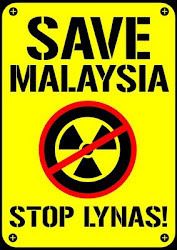How CAT could keep the LAMP lit...
Technorati tags: Lynas, LAMP, Environmental Damage, Hazardous Industrial Waste, Health Concerns, Low Level Radioactivity
Since he doesn’t want to waste your time with his rambling, and he doesn’t have the luxury of time at his disposal right now, Walski will cut to the chase : unless we want to abandon our smart phones, notebook computers, hybrid vehicles, and some green technologies (among other things), we’re going to need Rare Earth elements.
 That’s a reality of today’s technology-dependent life. If you want the Lynas Advanced Materials Plant (LAMP) totally shutdown, and you’re reading this on your smartphone or iPad, then you better think twice about what it is you’re asking for.
That’s a reality of today’s technology-dependent life. If you want the Lynas Advanced Materials Plant (LAMP) totally shutdown, and you’re reading this on your smartphone or iPad, then you better think twice about what it is you’re asking for.
Now, don’t get Walski wrong – he does not want severe environmental damage like what Malaysia witnessed earlier with the Asia Rare Earths plant in Bukit Merah (more on that later).
And yes, he is very wary of whether or not LAMP can operate safely as things stand today. Particularly after reading this article from Mother Jones earlier.
For Walski it is a conundrum, particularly when this very post is written on a device that has some form of rare earth element in it. Can we have our technology cake, and eat it without exposing our environment to severe risk from the ravaging damage that radiation and heavy metal poisoning can afflict?
Would it surprise you if Walski answered ‘yes’?
(eating our tech cake without radiation poisoning, and more, in the full post)
But before he explains himself, perhaps a recap of what Malaysians fear is in order.
The Bukit Merah ecological disaster is a living example of how rare earth refining can go terribly wrong, particularly when world standards for the handling of radioactive and other hazardous waste materials are not adhered to. The fact that Mitsubishi – one of the facility’s partners – is now quietly cleaning up the mess left behind does not prevent us from worrying that the same disaster could happen in Gebeng, Kuantan, where LAMP is currently being constructed.
 If you’ve been following this blog long enough, you may know that most of Walski’s working life has been spent in the process automation business. He’s seen plants with excellent safe operating practices, but he’s also seen some deplorable process facilities.
If you’ve been following this blog long enough, you may know that most of Walski’s working life has been spent in the process automation business. He’s seen plants with excellent safe operating practices, but he’s also seen some deplorable process facilities.
And it’s no big secret that when it comes to maintenance, the experience in Malaysia leaves much to be desired. That said, in the Oil & Gas and Petrochemical sectors, operating and safety procedures are quite stringent.
Still, even with the most stringent of procedures in place, accidents can happen. Most of these mishaps, however, are due to human errors. At least from what Walski has personally observed in his 20-some years working in the industry.
Which brings us back to LAMP.
From a technology standpoint, LAMP can operate safely, and has probably been designed with a high level of safety in mind. But the best designs can be undone by less than perfect implementation. And in the case of LAMP, there has been at least one implementation fault.
Engineers involved in the project said, and internal e-mails showed, that AkzoNobel withdrew from supplying the chemicals after it was told that the fiberglass liners would be installed in concrete-walled tanks that have a problem with rising dampness in the floors and cracks in the walls. AkzoNobel had been in discussions about the problem of rising dampness, but only became aware of the cracks this autumn, according to the engineers and the memos.
The engineers said they felt a professional duty to voice their safety concerns, but insisted on anonymity to avoid the risk of becoming industry outcasts.
(source: The New York Times, article dated January 31, 2012)
So, is the solution to trash the LAMP project altogether, or are there other alternatives? The danger posed by the facility should not be trivialized, as contamination of all manners are a very real possibility.
The solution here, as simple and straightforward as it may seem, is CAT. No, not the feline four-legged kind, but Clean, Accountable & Transparent. And this no-nonsense approach must be applied to ALL parties involved with the project – owners, contractors, and government agencies.
Plant project implementation, when not planned and done meticulously, can be rife with errors. Walski’s seen this happen with his own eyes. And for a project like LAMP, no error in implementation can be tolerated. CAT will definitely help in that respect.
And definitely NO CUTTING CORNERS (that’s what “Clean” means in this circumstance). Everything to specifications or better, no exceptions.
But for one reason or another, there has been obfuscation to a certain degree surrounding the implementation of the project and approval for it to operate. It appears that the problems surrounding the reactor vessel in the news quote snippet above (see also the Mother Jones article) were never quite revealed voluntarily.
Based on this, the question of “what else haven’t we been told” lies heavily on everyone’s mind. And if it doesn’t then it really should.
The way forward? As mentioned, CAT is the answer, applicable to ALL PARTIES involved. Particularly for the bigger concern of waste handling, once the plant is operational.
Thus far, most of the focus has been on the low level radioactive waste that will be produced. And with low level radiation, it’s prolonged exposure that’s more the concern, rather than single-dose exposure.
 Radiation dosage put into perspective
Radiation dosage put into perspective
(click on image or here for a larger view)
To Walski, while this is a very valid concern (for which no solution has yet been approved), there is also the question of the other nasty waste products, primarily acids and heavy metals. A major concern, especially when treated wastewater will be flowed back to the waterways, and scrubbed waste gasses to the atmosphere.
A pre-condition for approval to operate is a plan for proper waste disposal. In this very important area, CAT must be the modus operandi. No ifs, ands, or buts. By Transparent, all concerned parties must be informed in an honest manner.
And that is where Walski stands in all of this – unless we refuse to utilize any product that contains rare earth elements, a blanket opposition to Lynas and LAMP is rather hypocritical.
That, however, does not mean the plant can proceed without strict oversight during implementation and during its operational lifetime. And for that, CAT is the way to go.
It’s been said that the Gebeng area shouldn’t have been chosen as the site for LAMP in the first place, for a number of reasons. Namely, the site’s proximity to populated areas, and that prior to being opened up, the area was a peat swamp (hence the problem with moisture seeping through the tank/reactor base). In other words, the site is less than ideal.
But the facility is at a stage where relocation is no longer an option. Therefore the ONLY acceptable way the plant can proceed is if all the remaining flaws and faults are fully rectified, with full disclosure as to the nature and what corrective actions have been planned. And a credible plan for how all the facilities waste matter is to be disposed. And, close and honest monitoring by the relevant government oversight bodies. All in full-blown CAT mode, for sure.
Anything less than a willingness for full transparency, accountability and non-nonsense implementation, is an alarm bell, signifying that the safest way forward is for us to blow out the light on LAMP, before it even begins to operate, and potentially put Gebeng and its environs at risk.
















